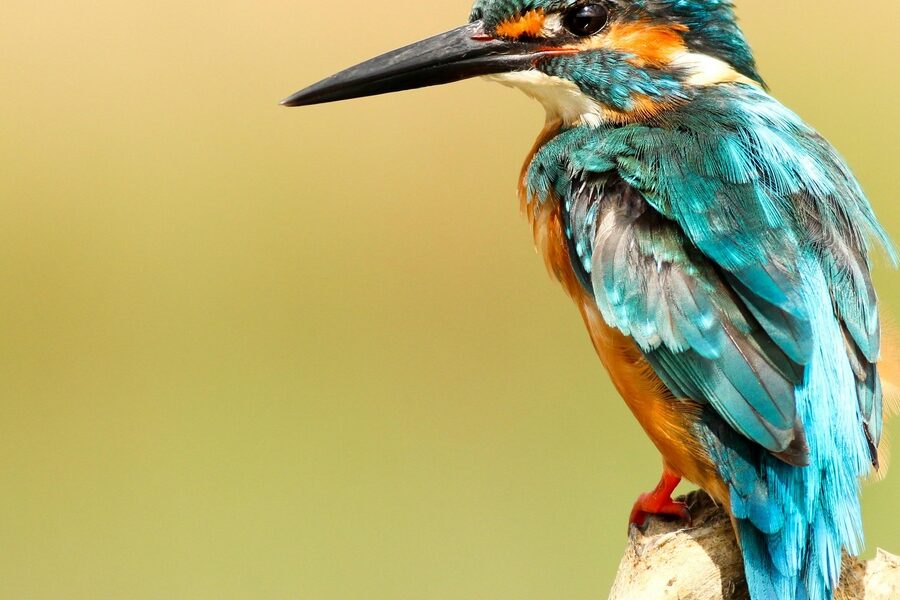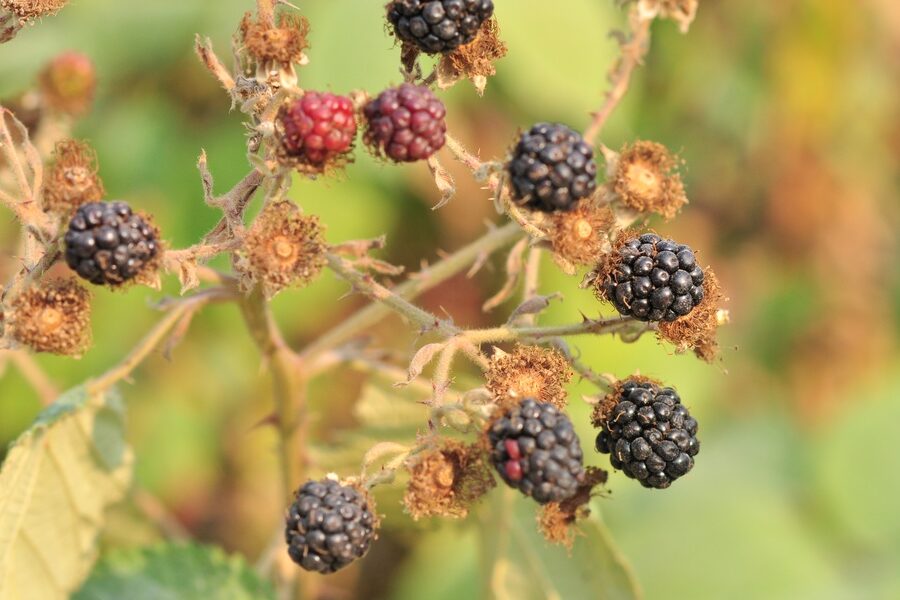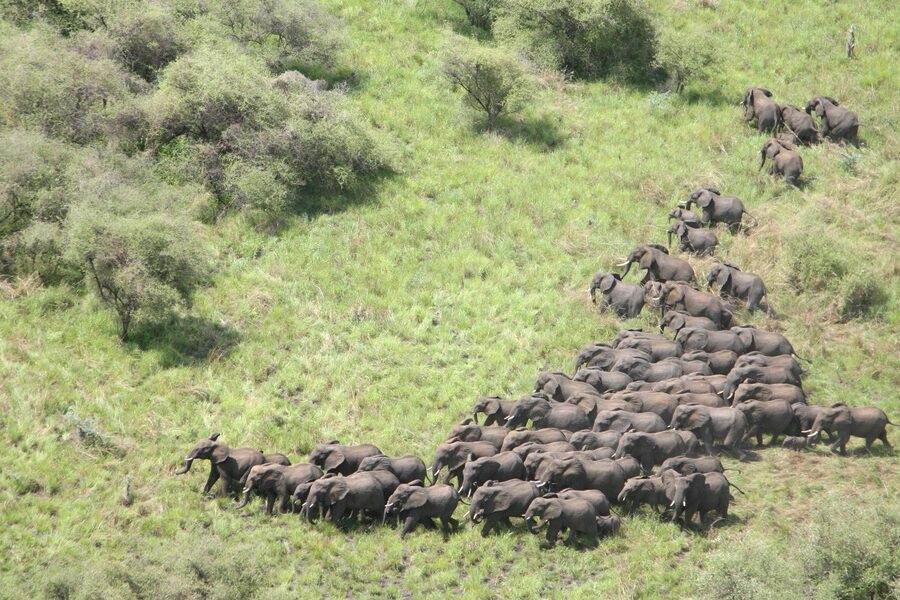Guinea’s varied landscapes—from coastal mangroves and lowland forests to inland savannas and Sahelian edges—support a wide array of birdlife that attracts local naturalists and visiting birdwatchers alike. Seasonal rains and habitat mosaics mean different species show up at different times and places, so a simple checklist can be very useful.
There are 95 Birds of Guinea, ranging from Abdim’s Stork to Yellow-throated Sandgrouse. Each entry is organized in columns: Scientific name, Status, Where found (regions & habitat), and you’ll find these details below.
How can I use this list for planning birdwatching trips in Guinea?
Use the Where found (regions & habitat) column to target specific sites (coasts, forests, savanna) and the Scientific name to match species in field guides or apps; the Status column flags rarity or conservation concern so you can prioritize visits and seasonal timing without wasting time on species unlikely to be present.
Are any of these species migratory or at conservation risk?
Yes—several are migratory and some face conservation threats; migratory behavior is evident from occurrence notes in the Where found column (and examples like Abdim’s Stork reflect seasonal movement), while the Status column points to local rarity or risk—check those entries and cross-reference IUCN listings for the latest assessments.
Birds of Guinea
| Common name | Scientific name | Status | Where found (regions & habitat) |
|---|---|---|---|
| Common Ostrich | Struthio camelus | Vagrant | Sahelian savannas in the far northeast. |
| White-faced Whistling Duck | Dendrocygna viduata | Widespread resident | Coastal and inland wetlands, rice paddies, rivers. |
| Fulvous Whistling Duck | Dendrocygna bicolor | Resident | Freshwater marshes, lakes, and rice fields, mainly in lowland areas. |
| White-backed Duck | Thalassornis leuconotus | Rare resident | Pools and marshes with dense floating vegetation. |
| Spur-winged Goose | Plectropterus gambensis | Widespread resident | Marshes, lakes, large rivers, and floodplains. |
| Egyptian Goose | Alopochen aegyptiaca | Resident | Rivers, dams, and wetlands, often in open country. |
| African Pygmy Goose | Nettapus auritus | Resident | Slow-moving rivers and swamps with water lilies. |
| Garganey | Spatula querquedula | Palearctic migrant | Freshwater marshes, flooded grasslands, and shallow lakes. |
| Northern Shoveler | Spatula clypeata | Palearctic migrant | Shallow wetlands, estuaries, and lagoons. |
| Helmeted Guineafowl | Numida meleagris | Widespread resident | Throughout Guinea except dense forest; savanna, farmland, open woodland. |
| White-throated Francolin | Peliperdix albogularis | Resident | Northern savannas and grassy woodlands. |
| Double-spurred Francolin | Pternistis bicalcaratus | Widespread resident | Savanna, scrub, and woodland edges throughout the country. |
| Ahanta Francolin | Pternistis ahantensis | Resident | Forest clearings, gallery forests, and farmbush in the south. |
| Latham’s Francolin | Peliperdix lathami | Resident | Primary and secondary rainforest floor. |
| Stone Partridge | Ptilopachus petrosus | Resident | Rocky hillsides and outcrops in savanna regions. |
| Common Quail | Coturnix coturnix | Breeder and migrant | Grasslands, savannas, and agricultural fields. |
| Little Grebe | Tachybaptus ruficollis | Widespread resident | Ponds, lakes, and slow-moving rivers with vegetation. |
| Great Crested Grebe | Podiceps cristatus | Vagrant | Large open freshwater bodies. |
| Rock Dove | Columba livia | Introduced resident | Towns, cities, and coastal cliffs. |
| Speckled Pigeon | Columba guinea | Widespread resident | Rocky areas, cliffs, towns, and open savanna. |
| Afep Pigeon | Columba unicincta | Resident | Canopy of primary and old secondary rainforest. |
| Western Bronze-naped Pigeon | Columba iriditorques | Resident | Rainforest canopy, particularly in southern Guinea. |
| Lemon Dove | Columba larvata | Resident | Undergrowth of montane forests, e.g., Mount Nimba, Fouta Djallon. |
| European Turtle Dove | Streptopelia turtur | Palearctic migrant | Open woodlands, savannas, and agricultural areas. |
| Dusky Turtle Dove | Streptopelia lugens | Vagrant | Highlands, potentially Fouta Djallon. |
| Red-eyed Dove | Streptopelia semitorquata | Widespread resident | Woodlands, savannas, and gardens. |
| Vinaceous Dove | Streptopelia vinacea | Widespread resident | Dry savannas and acacia scrub, especially in the north. |
| Mourning Collared Dove | Streptopelia decipiens | Resident | Dry acacia savanna near water, northern regions. |
| African Collared Dove | Streptopelia roseogrisea | Resident | Arid Sahelian scrub in the far north. |
| Laughing Dove | Spilopelia senegalensis | Widespread resident | Towns, villages, and dry savanna country. |
| Black-billed Wood Dove | Turtur abyssinicus | Resident | Dry woodlands and savanna, mainly in northern Guinea. |
| Blue-spotted Wood Dove | Turtur afer | Widespread resident | Forest edges, thickets, and moist woodlands. |
| Tambourine Dove | Turtur tympanistria | Resident | Forest undergrowth, dense thickets, and old farmbush. |
| Blue-headed Wood Dove | Turtur brehmeri | Resident | Primary and secondary rainforest understorey. |
| Namaqua Dove | Oena capensis | Resident | Arid and semi-arid savanna in the north. |
| Bruce’s Green Pigeon | Treron waalia | Resident | Savanna woodlands, especially near fruiting fig trees. |
| African Green Pigeon | Treron calvus | Widespread resident | Forest, woodland, and gardens, wherever there are fruiting trees. |
| Lesser Black-backed Gull | Larus fuscus | Palearctic migrant | Coastline, estuaries, and large inland rivers. |
| Grey-headed Gull | Chroicocephalus cirrocephalus | Resident | Coastal areas and large inland water bodies. |
| Black-headed Gull | Chroicocephalus ridibundus | Palearctic migrant | Coastal waters, estuaries, and lagoons. |
| Slender-billed Gull | Chroicocephalus genei | Palearctic migrant | Coastal lagoons and estuaries. |
| Black Tern | Chlidonias niger | Passage migrant | Coastal and inland wetlands during migration. |
| White-winged Tern | Chlidonias leucopterus | Passage migrant | Marshes, rice paddies, and coastal lagoons. |
| Whiskered Tern | Chlidonias hybrida | Passage migrant | Freshwater marshes and lakes. |
| Gull-billed Tern | Gelochelidon nilotica | Migrant and breeder | Coastal lagoons, saltpans, and large rivers. |
| Caspian Tern | Hydroprogne caspia | Migrant and resident | Coasts, estuaries, and large inland lakes. |
| Royal Tern | Thalasseus maximus | Resident and migrant | Coastal waters, sandy beaches, and islands. |
| Lesser Crested Tern | Thalasseus bengalensis | Migrant | Coastal and offshore waters. |
| Sandwich Tern | Thalasseus sandvicensis | Palearctic migrant | Coastline and offshore waters. |
| Common Tern | Sterna hirundo | Passage migrant | Coasts and inland waters, seen during migration. |
| Roseate Tern | Sterna dougallii | Breeder and migrant | Offshore islands and coastal waters. |
| Bridled Tern | Onychoprion anaethetus | Breeder | Offshore islands, pelagic waters. |
| Sooty Tern | Onychoprion fuscatus | Breeder | Breeds on offshore islands, otherwise highly pelagic. |
| Little Tern | Sternula albifrons | Breeder and migrant | Coastal beaches, lagoons, and sandbars. |
| African Skimmer | Rynchops flavirostris | Resident | Large rivers and lakes with sandbanks. |
| Chestnut-bellied Sandgrouse | Pterocles exustus | Resident | Arid savanna and semi-desert in the far north. |
| Four-banded Sandgrouse | Pterocles quadricinctus | Resident | Dry savanna and scrubland in northern Guinea. |
| Yellow-throated Sandgrouse | Pterocles gutturalis | Vagrant | Open grasslands and plains. |
| White-billed Buffalo Weaver | Bubalornis albirostris | Resident | Northern savanna with acacia and baobab trees. |
| Great White Pelican | Pelecanus onocrotalus | Migrant and breeder | Coastal estuaries, lagoons, and large inland lakes. |
| Pink-backed Pelican | Pelecanus rufescens | Widespread resident | Coastal and inland wetlands, lakes, and rivers. |
| Hamerkop | Scopus umbretta | Widespread resident | Marshes, rivers, streams, and ponds. |
| Shoebill | Balaeniceps rex | Vagrant | Papyrus swamps and marshes. |
| Yellow-billed Stork | Mycteria ibis | Resident | Shallow wetlands, riverbanks, and lake margins. |
| African Openbill | Anastomus lamelligerus | Resident | Marshes, rice paddies, and shallow lakes. |
| Black Stork | Ciconia nigra | Palearctic migrant | Rivers in forested or rocky areas. |
| Abdim’s Stork | Ciconia abdimii | Intra-African migrant | Open savannas and grasslands, often near villages. |
| Woolly-necked Stork | Ciconia episcopus | Resident | Wetlands, riverine forests, and grasslands. |
| White Stork | Ciconia ciconia | Palearctic migrant | Grasslands, wetlands, and farmlands. |
| Saddle-billed Stork | Ephippiorhynchus senegalensis | Resident | Marshes, rivers, and floodplains. |
| Marabou Stork | Leptoptilos crumeniferus | Widespread resident | Savannas, wetlands, and especially around human refuse sites. |
| Reed Cormorant | Microcarbo africanus | Widespread resident | Nearly any body of water, from small ponds to large rivers. |
| White-breasted Cormorant | Phalacrocorax lucidus | Resident | Coastal areas and large inland water bodies. |
| African Darter | Anhinga rufa | Widespread resident | Lakes, rivers, and swamps with calm water. |
| Northern Gannet | Morus bassanus | Palearctic migrant | Pelagic, seen offshore during migration. |
| Crowned Lapwing | Vanellus coronatus | Vagrant | Dry, open grasslands and savannas. |
| Black-headed Lapwing | Vanellus tectus | Resident | Dry savannas and semi-arid scrub in the north. |
| White-headed Lapwing | Vanellus albiceps | Resident | Sandbanks and sandbars on large rivers. |
| Spur-winged Lapwing | Vanellus spinosus | Widespread resident | Wetland edges, riverbanks, and irrigated fields. |
| Wattled Lapwing | Vanellus senegallus | Widespread resident | Moist grasslands, marshes, and recently burned areas. |
| Senegal Lapwing | Vanellus lugubris | Resident | Open grasslands and savannas. |
| Grey Plover | Pluvialis squatarola | Palearctic migrant | Coastal mudflats, estuaries, and sandy beaches. |
| Common Ringed Plover | Charadrius hiaticula | Palearctic migrant | Coastal mudflats, beaches, and inland wetlands. |
| Little Ringed Plover | Charadrius dubius | Palearctic migrant | Freshwater habitats; sandbars, gravel pits, and riverbanks. |
| Kittlitz’s Plover | Charadrius pecuarius | Resident | Bare ground near water; saltpans, dry mudflats, and short grass. |
| Kentish Plover | Charadrius alexandrinus | Palearctic migrant | Sandy coasts, saltpans, and coastal lagoons. |
| Forbes’s Plover | Charadrius forbesi | Intra-African migrant | Rocky outcrops (inselsbergs) and bare ground in savannas. |
| White-fronted Plover | Charadrius marginatus | Resident | Coastal sandy beaches and sandbanks. |
| Eurasian Oystercatcher | Haematopus ostralegus | Palearctic migrant | Coastal mudflats and rocky shores. |
| Black-winged Stilt | Himantopus himantopus | Resident and migrant | Shallow freshwater and brackish wetlands. |
| Spotted Redshank | Tringa erythropus | Palearctic migrant | Coastal and inland wetlands. |
| Common Redshank | Tringa totanus | Palearctic migrant | Coastal mudflats, saltmarshes, and estuaries. |
| Marsh Sandpiper | Tringa stagnatilis | Palearctic migrant | Shallow freshwater marshes, lagoons, and rice paddies. |
| Common Greenshank | Tringa nebularia | Palearctic migrant | A wide range of coastal and inland wetlands. |
| Green Sandpiper | Tringa ochropus | Palearctic migrant | Freshwater habitats like streams, ditches, and sewage ponds. |
Images and Descriptions

Common Ostrich
The world’s largest bird, unmistakable but now an extremely rare vagrant in Guinea’s northernmost savannas. Its presence is historical or accidental, linked to populations in neighboring Mali.
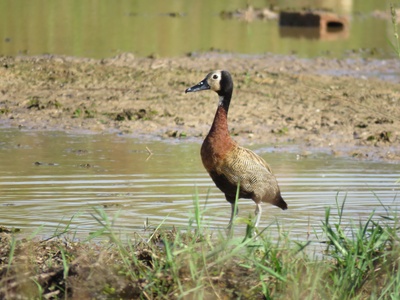
White-faced Whistling Duck
A distinctive goose-like duck with a striking white face, black hindneck, and chestnut breast. Named for its clear, three-note whistling call, often heard as flocks fly overhead.

Fulvous Whistling Duck
A long-necked, largely tawny-brown duck. Often found in flocks with other whistling ducks, it is a common sight in Guinea’s wetlands, feeding on aquatic plants and seeds.

White-backed Duck
A strange, secretive duck that often sits low in the water like a grebe. It has a mottled brown body, a distinctive white patch at the base of its bill, and a namesake white back, usually only visible in flight.

Spur-winged Goose
Africa’s largest waterfowl, this massive “goose” is actually a unique perching duck. It’s mostly black with a white face and belly, and has a sharp spur on the bend of its wing for fighting.

Egyptian Goose
A noisy and aggressive goose-like duck, pale brown and grey with a distinct dark brown eye-patch. It stands tall on long pink legs and is often seen in pairs guarding its territory fiercely.

African Pygmy Goose
Africa’s smallest waterfowl, this stunningly patterned duck is barely larger than a pigeon. Males are iridescent green and white with a bright yellow bill; females are duller. They feed on lily seeds.

Garganey
A small dabbling duck that winters in Guinea. The male is notable for his broad white eyebrow stripe on a brown head. They are shy and prefer wetlands with good cover.

Northern Shoveler
Easily identified by its enormous, spatula-shaped bill, used to filter food from the water. Males are striking with a green head, white chest, and chestnut flanks during their winter stay.

Helmeted Guineafowl
A large, chicken-like bird with a polka-dotted dark grey body and a bare blue-and-red head topped with a bony casque. Often seen in noisy, sociable flocks foraging on the ground.
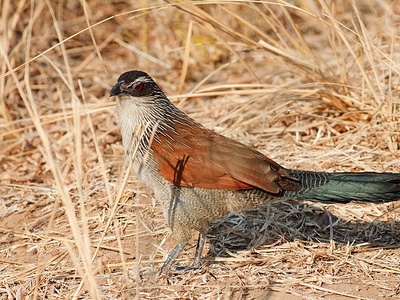
White-throated Francolin
A small, terrestrial gamebird with finely barred brown plumage and a conspicuous white throat patch. It is secretive, preferring to run through dense grass rather than fly when disturbed.
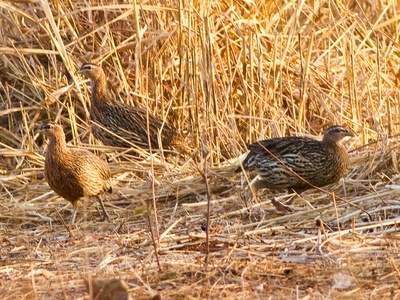
Double-spurred Francolin
A common, chicken-sized francolin named for the two spurs on the male’s legs. It has a streaked brown body, a white eyebrow, and a distinctive, loud cackling call heard at dawn and dusk.

Ahanta Francolin
A secretive and little-known francolin of the forest zone. It is dark grey-brown with fine white streaking on its underparts and a reddish-brown face. Usually detected by its ringing calls.

Latham’s Francolin
A shy and retiring forest-dwelling francolin. It is richly patterned in chestnut and black, providing excellent camouflage among the leaf litter where it forages for insects and fallen fruit.

Stone Partridge
A unique, plump partridge found in rocky habitats. It has dark, barred plumage and a red eye-ring and legs. When flushed, it flies a short distance before dropping back into cover.

Common Quail
A small, stocky gamebird, more often heard than seen. Its explosive “wet-my-lips” call is a characteristic sound of grassy areas. It is cryptically coloured in buffs and browns.

Little Grebe
A small, dumpy waterbird that dives expertly for fish and invertebrates. In breeding plumage, it has a chestnut throat and puffy, rounded rear. Its call is a high-pitched, whinnying trill.
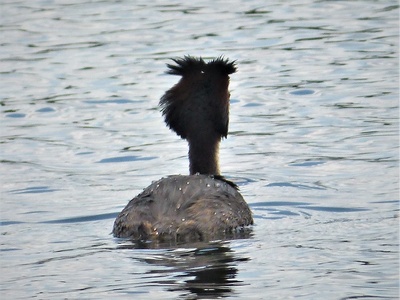
Great Crested Grebe
An elegant waterbird, larger than other grebes, with a slender neck. Famous for its elaborate courtship “weed dance.” It is a very rare vagrant to Guinea, far from its usual ranges.

Rock Dove
The common city pigeon, introduced worldwide. Found in urban areas throughout Guinea, particularly around human settlements. Varies greatly in colour from grey to white, brown, and pied.

Speckled Pigeon
A large, handsome pigeon, grey with speckled white spots on its wings and a patch of bare red skin around the eye. It has adapted well to cities, often nesting on buildings.

Afep Pigeon
A large, shy pigeon of the forest canopy. It is pale grey with a distinctive white band across its lower back, most obvious in flight. Its deep, booming call echoes through the forest.
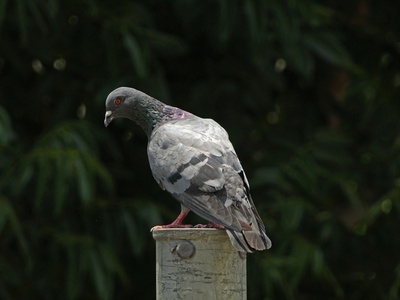
Western Bronze-naped Pigeon
A beautiful but difficult-to-see pigeon of the forest interior. The male has an iridescent, bronze-and-purple hindneck. Often seen in flight high over the canopy or at fruiting trees.
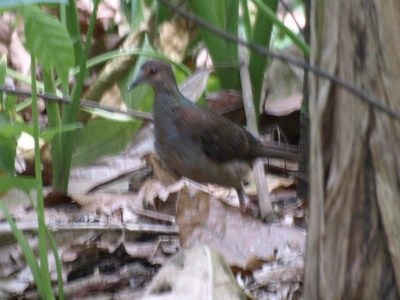
Lemon Dove
A terrestrial, brownish-grey dove with a pale face and a subtle iridescent sheen on its neck. It forages quietly on the forest floor, walking slowly to find fallen seeds and fruit.

European Turtle Dove
A declining migrant from Europe, wintering in northern Guinea. A small, slender dove with a chestnut-and-black scaled pattern on its wings and a striped neck patch. Known for its gentle, purring call.
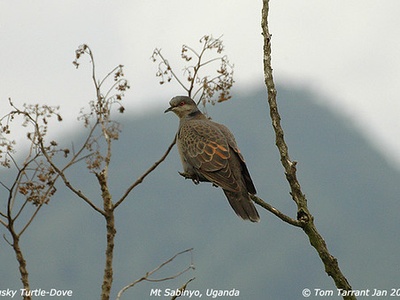
Dusky Turtle Dove
An Afrotropical highland species, typically found further east. Its occurrence in Guinea would be exceptional, likely as a vagrant. It’s a dark, sooty-brown dove with a white-edged tail.

Red-eyed Dove
A large, common dove with a vinous-pink head and chest, a black half-collar on the neck, and a prominent red ring around the eye. Its cooing call is a familiar sound across Guinea.
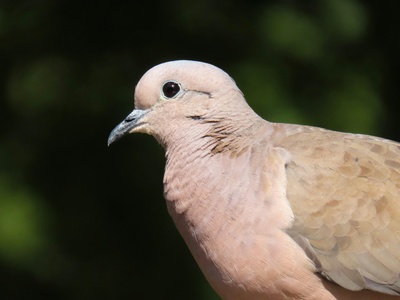
Vinaceous Dove
A pale, sandy-pinkish dove of arid country. It is distinguished from similar doves by its call, a rapidly accelerating “coo,” and the extensive white in its tail corners.

Mourning Collared Dove
A pale grey dove similar to other collared species, best identified by its voice—a mournful, descending “cooo-coo-coo.” It prefers drier habitats than the Red-eyed Dove.

African Collared Dove
A very pale, creamy-grey dove of desert edges. It is the wild ancestor of the domestic Barbary Dove. Its gentle coo is softer and higher-pitched than that of its relatives.

Laughing Dove
A small, long-tailed dove, common around human habitation. It has a pinkish-brown head and breast, blue-grey on the wings, and a call that sounds like a soft, bubbling laugh.

Black-billed Wood Dove
A small, delicate ground dove of arid country. It has blue-grey wing spots and, crucially, an entirely black bill. Its call is a series of soft, accelerating coos that then fade away.

Blue-spotted Wood Dove
Similar to the Black-billed Wood Dove but prefers wetter habitats. It is identified by its iridescent blue-green wing spots and a bill that is red at the base and yellow at the tip.

Tambourine Dove
A striking little dove with a clean white face and underparts contrasting with dark brown upperparts. It forages secretively on the forest floor and has a call like a series of soft drum taps.

Blue-headed Wood Dove
A rich chestnut-brown dove with a contrasting pale blue-grey head. A true forest specialist, it forages quietly on the dark forest floor and is rarely seen away from deep shade.

Namaqua Dove
An elegant, tiny dove with a very long, tapering black tail. The male is unmistakable with his black face and breast. Often seen feeding on the ground in open, dry country.

Bruce’s Green Pigeon
A large, nomadic pigeon, primarily yellowish-green with a lilac shoulder patch. It gathers in large, noisy flocks to feed on wild figs, clambering about the branches like a parrot.

African Green Pigeon
A stocky, parrot-like pigeon, mostly green with a yellow wash and a lilac patch at the shoulder. It is identified by its bare, red base to the bill and red feet. Its call is a bizarre series of clicks, whistles, and growls.
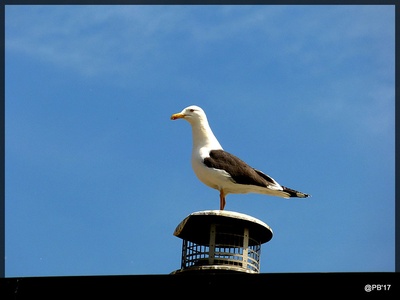
Lesser Black-backed Gull
A large gull that winters along Guinea’s coast. Adults have a dark grey to black back (mantle), yellow legs, and a powerful yellow bill with a red spot. Smaller than the very rare Great Black-backed Gull.

Grey-headed Gull
A medium-sized gull, common along the coast. In breeding plumage, it has a pale grey hood (not black like some species), a red bill, and red legs. Often seen scavenging or following fishing boats.

Black-headed Gull
A common winter visitor from Eurasia. In winter plumage, it lacks the full chocolate-brown head, showing just a dark smudge behind the eye. Has a slender, dark reddish bill and legs.
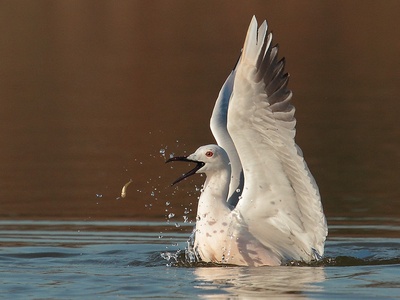
Slender-billed Gull
An elegant, pale gull similar to the Black-headed Gull but with a longer, more slender bill, a sloping forehead giving a “gentle” look, and a pinkish flush on the breast in breeding season.

Black Tern
A small, delicate marsh tern. In its winter and passage plumage seen in Guinea, it is mostly grey and white with a distinctive black cap and a dark patch on the side of its breast.
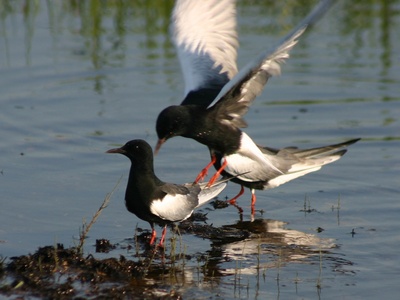
White-winged Tern
Another small marsh tern seen on migration. In winter plumage, it resembles the Black Tern but generally has a cleaner white appearance and lacks the dark breast-side patch.

Whiskered Tern
Slightly larger than other ‘marsh terns’. In non-breeding plumage it has a streaked black cap and a stouter bill. Feeds by dipping to the water’s surface to pick up insects and small fish.

Gull-billed Tern
A stocky, medium-sized tern with a thick, all-black, gull-like bill and broad wings. It feeds more like a gull, often hunting for insects over land as well as fish over water.

Caspian Tern
The world’s largest tern, almost the size of a gull. It has a massive, dagger-like red-orange bill with a dark tip. Its call is a deep, harsh “kraa.” A powerful flyer and diver.

Royal Tern
A very large, elegant tern with a shaggy crest and a long, bright orange-yellow bill. It is a common sight along Guinea’s coastline, plunge-diving for fish in spectacular fashion.
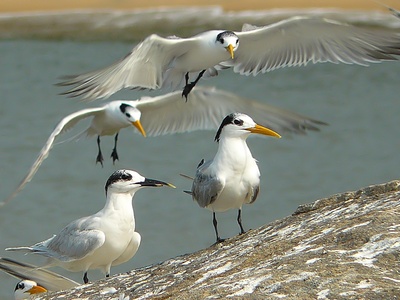
Lesser Crested Tern
Similar to other crested terns but smaller than the Royal Tern. It has a slender, bright orange bill and a shaggy black crest. Often seen in mixed flocks with other tern species.

Sandwich Tern
A medium-large tern, common along the coast in winter. It is identified by its slender black bill with a distinct yellow tip, and a shaggy black crest. Gregarious and noisy.

Common Tern
A graceful, medium-sized tern with long tail-streamers. Migrating birds have a dark carpal bar on the wing, a blackish bill, and a receding black cap. A classic “sea swallow.”
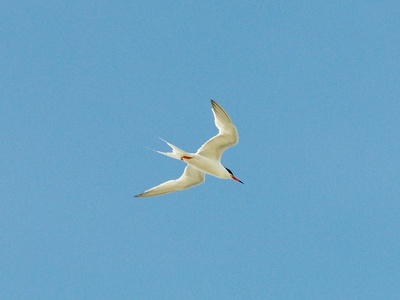
Roseate Tern
An exceptionally graceful tern with very long, flexible white tail-streamers. In breeding plumage, it has a faint rosy-pink flush on its underparts and a mostly black bill. A threatened species.
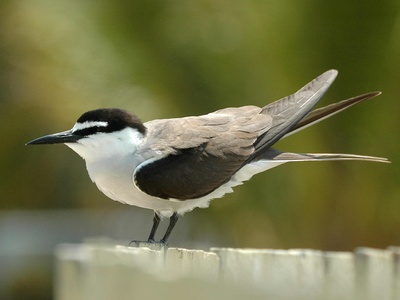
Bridled Tern
A dark-backed “sooty” tern of tropical seas. It is distinguished from the Sooty Tern by its paler grey-brown back, a more extensive white forehead patch, and a white collar.
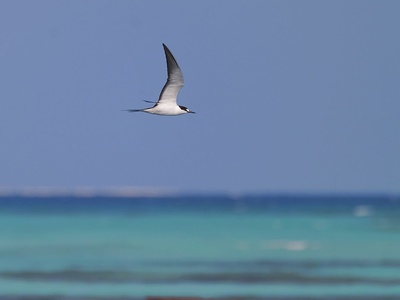
Sooty Tern
A classic tropical seabird with jet black upperparts and clean white underparts. It spends years at sea, only returning to land to breed on remote islands.

Little Tern
A very small, agile tern. In breeding plumage, it has a yellow bill with a black tip and a white patch on its forehead below the black cap. Hovers expertly before diving for small fish.

African Skimmer
An extraordinary bird with a unique bill structure—the lower mandible is much longer than the upper. It flies low over water, slicing the surface with its lower bill to catch fish.

Chestnut-bellied Sandgrouse
A pigeon-like bird of dry country. Males have a narrow black breast band and a chestnut belly. They are famous for flying long distances to waterholes to soak their belly feathers to carry water to their chicks.

Four-banded Sandgrouse
A cryptically patterned ground bird. The male is handsome with a striking black and white pattern on his forehead and two black-and-white bands across his chest. Mostly active at dawn and dusk.

Yellow-throated Sandgrouse
The largest sandgrouse, a very rare vagrant from East and Southern Africa. A heavy-bodied bird with a plain face, and the male has a yellowish throat. Unlikely to be seen in Guinea.

White-billed Buffalo Weaver
A large, noisy, and sociable weaver. Mostly black with a massive, conical, whitish bill. They build huge, messy communal nests of thorny sticks in large trees.

Great White Pelican
A huge, unmistakable waterbird, mostly white with black flight feathers and a massive pinkish-yellow throat pouch. Often fishes cooperatively, herding fish into the shallows.
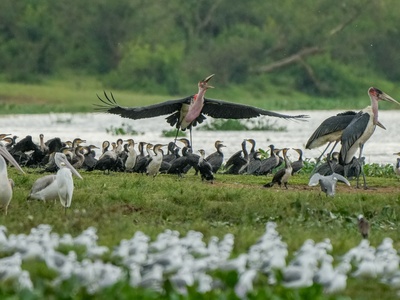
Pink-backed Pelican
Slightly smaller than the Great White Pelican, and appears greyish rather than pure white. In breeding season, adults have a pinkish wash on their backs. Nests colonially in trees.

Hamerkop
A unique, medium-sized brown bird with a thick crest on the back of its head, giving it a hammer-headed shape. It builds enormous, messy, domed nests of sticks, often in a river fork.
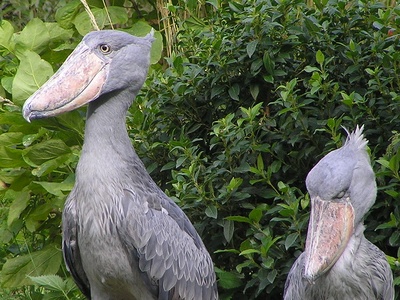
Shoebill
An iconic and massive bird, unmistakable with its huge, clog-shaped bill. It is slaty-grey and stands motionless for long periods hunting lungfish. An exceptionally rare vagrant to Guinea.

Yellow-billed Stork
A medium-sized stork, mostly white with black flight feathers. It is easily identified by its long, bright yellow bill and red face. It fishes by touch, sweeping its open bill through the water.

African Openbill
A medium-sized, all-black stork with a unique bill that has a gap between the two mandibles, used for handling its main prey, large water snails. Often seen soaring in flocks.
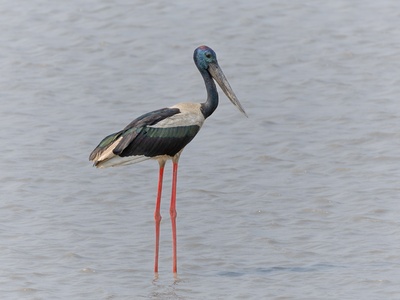
Black Stork
A shy and solitary migrant. It is mostly glossy black with a white belly and bright red legs and bill. It wades stealthily in clear streams, hunting for fish, unlike the more open-country White Stork.

Abdim’s Stork
The world’s smallest stork, often called the “grasshopper stork” as it follows locust swarms. It is black with a white belly, and has blue and red skin on its face. Arrives with the rains.

Woolly-necked Stork
A medium-large stork with a glossy black body, a white belly and undertail, and a distinctive “woolly” white neck. It is a widespread but generally uncommon and solitary species.
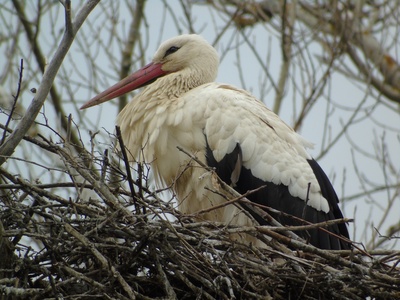
White Stork
A familiar large, white bird with black flight feathers and a long red bill and legs. Winters in huge numbers in Africa, often seen foraging for insects in recently burned grasslands.
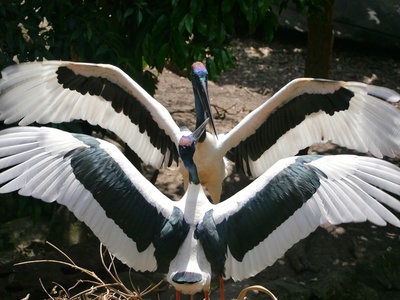
Saddle-billed Stork
A magnificent, giant stork, one of Africa’s tallest flying birds. It is strikingly patterned in black and white with a massive red-and-black bill featuring a yellow “saddle” at the base.

Marabou Stork
A huge, ugly-but-impressive stork with a bare pink head, a massive bill, and a large inflatable throat pouch. A scavenger, often found at rubbish dumps and abattoirs.

Reed Cormorant
A small, dark cormorant with a relatively long tail. In breeding plumage, adults are glossy black with a small crest. Often seen perched on posts or branches with wings spread to dry.

White-breasted Cormorant
A large cormorant, essentially the African version of the Great Cormorant. It is black with a contrasting clean white throat and breast. Often perches on rocks or buoys.

African Darter
A slender, long-necked waterbird, often called the “snakebird” because it swims with only its sinuous neck and head above water. It spears fish with its sharp, dagger-like bill.

Northern Gannet
A large, powerful seabird, pure white with black wingtips and a yellowish wash on the head. It performs spectacular high-speed plunge dives from great heights to catch fish.

Crowned Lapwing
A striking plover with a black cap encircled by a white “crown” or halo. It is a bird of dry country, and its presence in Guinea would be as a rare vagrant from further east.

Black-headed Lapwing
A handsome lapwing with a wispy crest, a black head divided by a white line, and yellow facial wattles. Its call is a sharp, metallic “tink-tink.”

White-headed Lapwing
An unmistakable lapwing of major rivers like the Niger. It has a clean white head, large yellow facial wattles, and sharp wing spurs. Gives loud, piping calls.
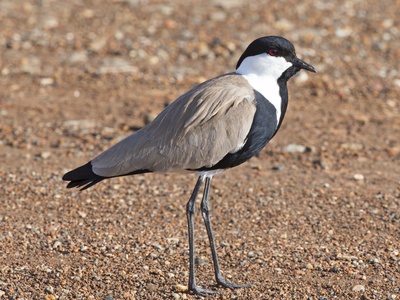
Spur-winged Lapwing
A common and noisy lapwing of wetlands. It is boldly patterned in black, white, and brown, and has a small sharp spur at the bend of its wing. Very aggressive towards intruders.
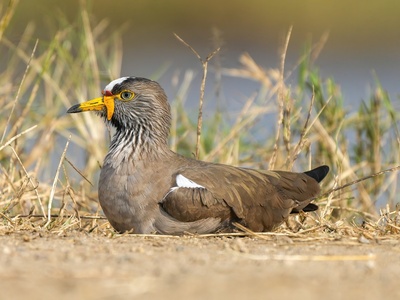
Wattled Lapwing
A large, lanky lapwing with long yellow legs and prominent yellow wattles hanging down from its face. It is noisy and conspicuous, often gathering in small flocks.
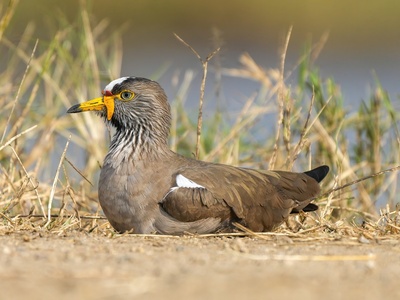
Senegal Lapwing
A plainer, more subtle lapwing with a grey head and breast. It lacks wattles or crests. It prefers drier habitats and is known for its mournful, piping “tee-yoo” call.
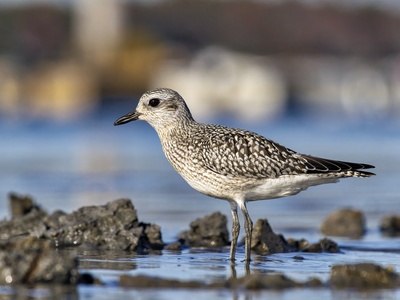
Grey Plover
A stocky, medium-sized wader, common on the coast in winter. In non-breeding plumage it is a mottled grey-brown above and white below. Has a distinctive black “armpit” patch visible in flight.
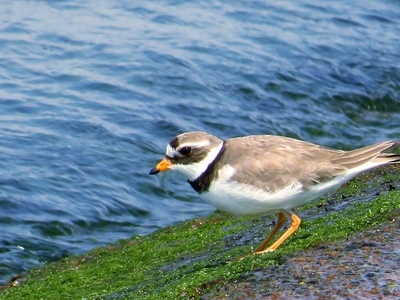
Common Ringed Plover
A small, active wader with a single black breast band, an orange bill with a black tip, and orange legs. Often seen running and stopping abruptly to pick up food items.

Little Ringed Plover
Very similar to the Common Ringed Plover, but prefers freshwater. It is best distinguished by its plain, dark bill, duller legs, and a prominent yellow eye-ring.

Kittlitz’s Plover
A small, pale plover with long greyish legs. It has a distinctive habit of kicking sand over its nest to conceal it. Its call is a soft “pipip.”
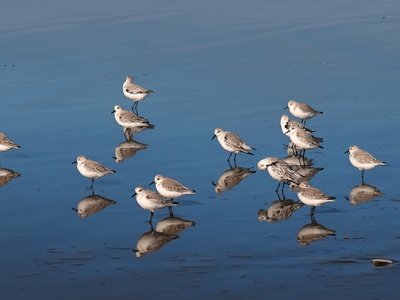
Kentish Plover
A small, pale plover with an incomplete breast band and dark legs. It is a common winter visitor to Guinea’s coastline, often seen foraging at the water’s edge on beaches.

Forbes’s Plover
An unusual plover that breeds on bare rock surfaces during the wet season. It has a distinctive facial pattern with a white line above the eye connecting to a white collar.
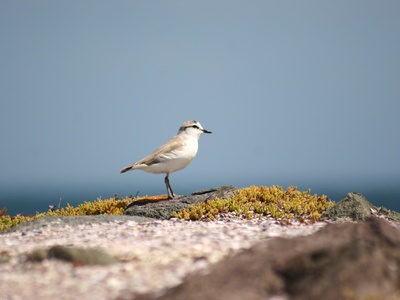
White-fronted Plover
A very pale, sandy-coloured plover that blends in perfectly with the beach environment. It has a white forehead and a variable, faint breast band. Runs rapidly along the shoreline.

Eurasian Oystercatcher
A large, noisy, and conspicuous black-and-white wader with a long, stout, bright orange-red bill and pink legs. Uses its powerful bill to pry open shellfish or probe for worms.

Black-winged Stilt
An elegant, unmistakable wader, black and white with incredibly long, thin, pinkish-red legs. It wades through shallow water, picking insects from the surface with its fine black bill.

Spotted Redshank
An elegant wader, seen in Guinea in its drab grey-and-white winter plumage. It is more slender than a Redshank, with a longer, finer bill, and often feeds in deeper water.
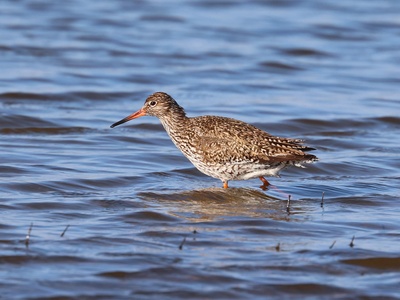
Common Redshank
A common wintering wader, noisy and alert. It has bright orange-red legs and a red-based bill. In flight, it shows a broad white trailing edge on its wings, a key ID feature.
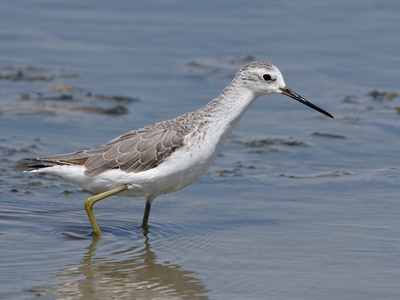
Marsh Sandpiper
A very graceful and slender wader, looking like a miniature Greenshank. It has long, fine, greenish legs and a needle-like bill. It feeds with quick, nervous movements.
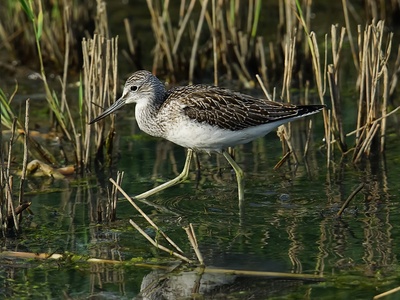
Common Greenshank
A large, elegant sandpiper with long, dull greenish-yellow legs and a slightly upturned, two-toned bill. Its loud, ringing “tew-tew-tew” call is a common sound in wetlands.

Green Sandpiper
A dark, solitary wader that prefers small freshwater bodies. It has a distinctive habit of bobbing its head and tail. In flight, it shows a striking white rump and dark underwings.



